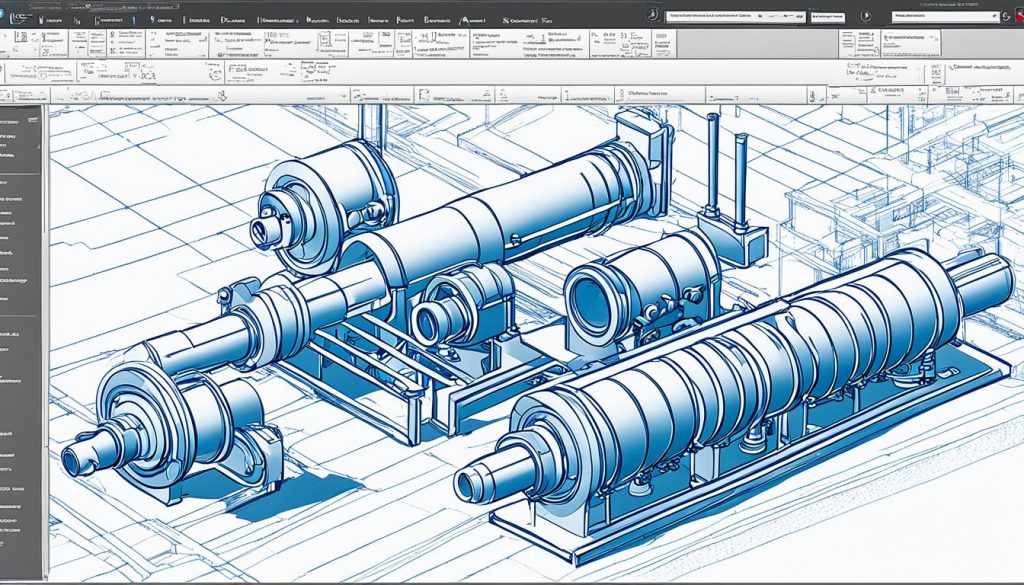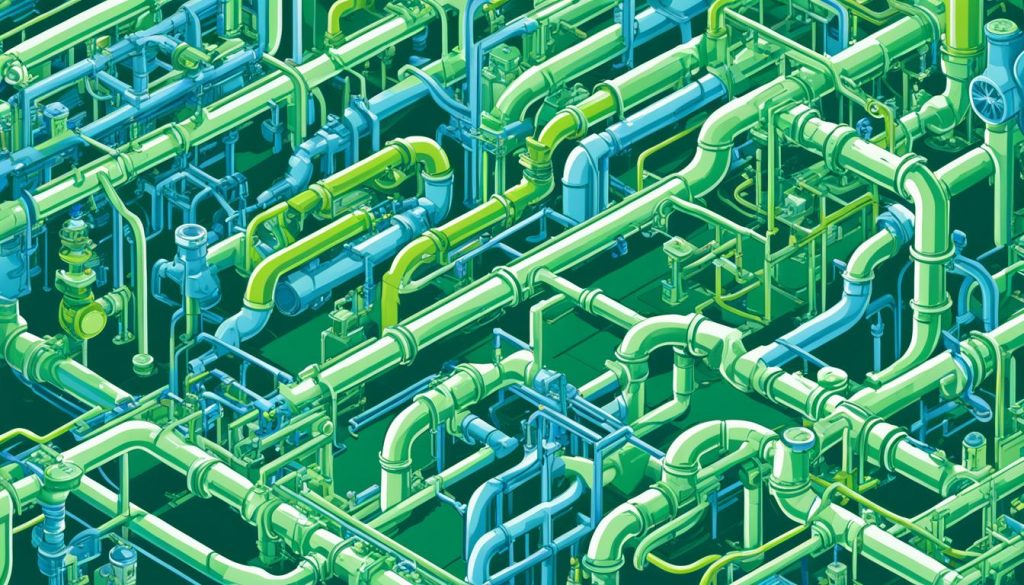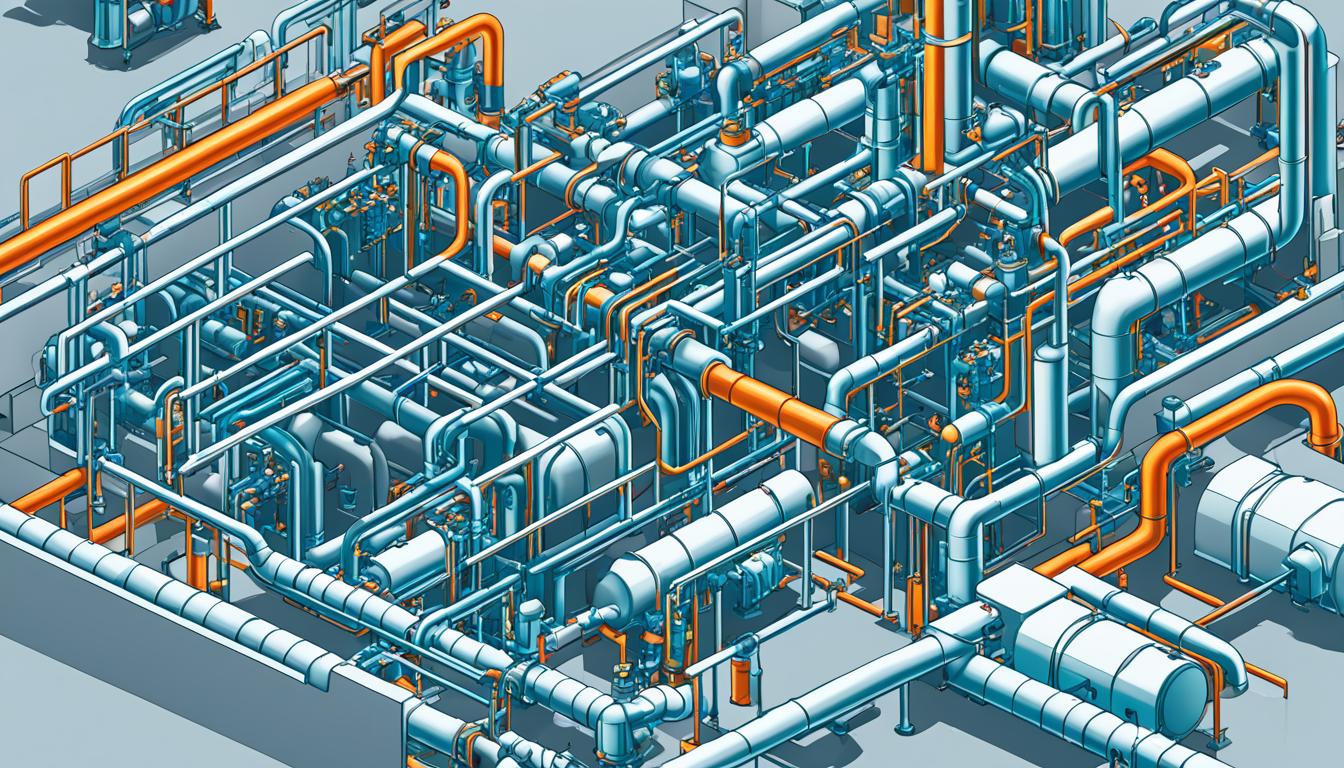AutoCAD HVAC software helps you make piping designs better by offering tools for accurate and detailed layouts. This software is great for mechanical engineering. It makes designing HVAC systems easier and more efficient.
AutoCAD has special tools for making 2D and 3D models of pipes. It automates tasks and checks your piping systems for problems. With customizable settings and cloud collaboration, making piping designs better is easier.
Learning AutoCAD HVAC software lets you handle complex piping projects. It boosts system performance and helps you meet industry standards. Let’s see how this software can improve your HVAC projects.
Introduction to AutoCAD HVAC Software for Piping Design
AutoCAD HVAC software changes the game in piping design with its advanced tools. It makes creating complex HVAC systems easier. This is vital for engineers and designers in the field.
Key features of AutoCAD for HVAC applications
AutoCAD MEP has many tools for HVAC drafting. These include:
- Customizable piping layout tools
- Extensive symbol libraries for HVAC components
- Automated ductwork and piping systems
- 3D modeling capabilities for complex designs
Benefits of using AutoCAD in piping design
Using AutoCAD for HVAC projects has many benefits:
| Benefit | Description |
|---|---|
| Improved accuracy | Precise measurements and calculations reduce errors |
| Increased productivity | Automation features speed up design processes |
| Enhanced collaboration | Easy sharing of digital files among team members |
| Cost reduction | Fewer errors lead to reduced material waste and rework |
Overview of piping design optimization process
The optimization process in AutoCAD HVAC software includes several steps:
- Setting up the project environment
- Creating initial layouts using piping layout tools
- Adding HVAC components and fittings
- Optimizing pipe routing for efficiency
- Performing clash detection and resolving conflicts
- Generating detailed documentation and reports
By following this process, you can make HVAC piping designs that are efficient, accurate, and cost-effective. AutoCAD’s powerful features help a lot.
Setting Up Your AutoCAD Environment for HVAC Projects
Getting your AutoCAD workspace ready for HVAC projects is key to efficient piping design. Customizing your environment helps you work faster and more effectively. Let’s look at the main steps to make your AutoCAD setup ideal for HVAC work.
Customizing Tool Palettes and Workspaces
Start by customizing tool palettes for your HVAC needs. Make a palette for piping parts like pipes, valves, and fittings. Arrange these items so you can find them quickly during design. Use dynamic blocks to show many types of parts, cutting down on the number of blocks you need.
Configuring Drawing Settings and Units
Setting up your HVAC drawing settings is crucial for accuracy. Choose your units, usually imperial or metric, based on the project. Set your grid and snap settings for precise piping placement. Make sure text and dimensions are clear at all scales by adjusting annotation scales.
Creating and Managing Layers for Piping Elements
Good layer management is key for tidy HVAC designs. Make layers for each piping system, like supply, return, and exhaust. Use different colors and linetypes to tell them apart. Layer states help control what you see, making editing and working with others easier.
| Layer Name | Color | Linetype | Description |
|---|---|---|---|
| HVAC-Supply | Red | Continuous | Supply piping system |
| HVAC-Return | Blue | Dashed | Return piping system |
| HVAC-Exhaust | Green | Center | Exhaust piping system |
By using these AutoCAD setup tips, you’ll have a workspace perfect for HVAC piping design. This setup will make you more efficient and accurate at every stage of the project.
Fundamental AutoCAD Commands for Piping Layout
AutoCAD piping commands are key for making HVAC systems work well. They help you create precise and detailed designs. Let’s look at the main commands that make your work easier and faster.
The Line and Polyline commands are perfect for drawing pipes. Use the Orthogonal drawing mode for right-angle connections. This is important for keeping the flow right in your HVAC system. Grip editing lets you easily change parts of your design as needed.
External References (Xrefs) are crucial for big projects. They let you work on different parts of your design in separate files. This way, you can improve collaboration and keep files smaller.
- Line and Polyline for pipe drawing
- Orthogonal mode for right-angle connections
- Grip editing for component manipulation
- Xrefs for managing complex projects
- Annotation tools for labeling and dimensioning
Annotation and dimensioning tools are key for clear layouts. They help you label parts, show measurements, and make parts lists. Good annotation makes sure everyone understands your HVAC system layout.
To make duct routing better, use AutoCAD’s HVAC tools. These tools help you make efficient paths. This reduces pressure drops and boosts system performance. Learning these basic commands prepares you to handle complex piping designs.
Optimize Piping Design with AutoCAD HVAC Software
AutoCAD HVAC software has powerful tools for piping design optimization. These tools help you create efficient and cost-effective HVAC systems. Let’s see how to use AutoCAD’s features for your projects.
Utilizing specialized HVAC tools and features
AutoCAD piping tools make designing easier. The software has tools like pipe routing preferences and fluid dynamics simulation. These help you make accurate layouts and check system performance. You can quickly set up pipe networks, add fittings, and figure out flow rates.
Implementing best practices for efficient piping layout
Creating efficient piping layouts is key for HVAC design optimization. Keep these points in mind:
- Proper component spacing
- Optimal pipe sizing
- Minimizing bends and turns
- Balancing system pressure
AutoCAD’s tools for measurement and analysis help you reach these goals. You can tweak layouts to boost efficiency and cut down on costs.
Leveraging parametric constraints for flexibility
Parametric constraints change the game in HVAC design. They let you link different parts of your piping system. When you change one part, others adjust automatically. This saves time and keeps your design consistent.
| Constraint Type | Function | Benefit |
|---|---|---|
| Geometric | Maintains shape and position | Ensures proper alignment |
| Dimensional | Controls sizes and distances | Maintains correct spacing |
| Equality | Keeps elements identical | Ensures uniform components |
Mastering these AutoCAD HVAC software features will boost your piping design process. You’ll get more efficient, accurate, and flexible HVAC systems. These systems will meet project needs and impress clients.
Advanced Techniques for 3D Piping Modeling
3D HVAC modeling elevates piping design. AutoCAD’s tools let you craft complex pipe networks easily. Let’s dive into new techniques that will change your work.
Creating 3D Pipe Networks and Fittings
AutoCAD’s 3D modeling lets you design realistic pipe networks. Begin by sketching your layout. Then, use the 3D pipe tool to bring it to life. Add fittings like elbows and valves for a complete system.
This method gives you a clear view of your piping. It makes finding problems easier.
Using 3D Visualization for Clash Detection
Clash detection is key in HVAC design. With 3D visualization, you can spot conflicts before building starts. Rotate and zoom to check for clashes.
This saves time and money by avoiding costly changes on-site.
Integrating 3D Scans for Accurate Retrofitting
3D scanning adds precision to retrofitting. By using point cloud data from laser scans, you can model new piping around existing structures. This ensures your designs fit perfectly, reducing clashes.
It’s a must-have for renovations in complex buildings.
Mastering these 3D modeling techniques leads to better HVAC designs. Use these tools to improve your workflow and impress your clients.
Automating Piping Design Processes in AutoCAD
AutoCAD automation changes the game for piping design. It uses powerful tools to make your HVAC work better. Let’s see how to make your work more efficient with piping design scripts and automation.

Piping design scripts are a big deal for your projects. They automate boring tasks, letting you focus on important design choices. With AutoCAD automation, you’ll make fewer mistakes and work faster.
Start improving your HVAC workflow by finding tasks that take too long. Once you know what they are, make scripts to do them automatically. This saves time and makes your designs more consistent.
- Automate component placement along pipe runs
- Update annotations to match new standards
- Generate bill of materials automatically
- Create custom pipe fittings with parametric constraints
AutoCAD’s AutoLISP lets you create custom tools. You can make everything from simple shortcuts to complex algorithms. This boosts your HVAC workflow even more.
| Automation Task | Time Saved | Error Reduction |
|---|---|---|
| Component Placement | 60% | 75% |
| Annotation Updates | 70% | 90% |
| Bill of Materials Generation | 80% | 95% |
| Custom Fitting Creation | 50% | 85% |
Using AutoCAD automation and piping design scripts does more than save time. It improves your work’s quality, cuts down on mistakes, and frees up resources for new ideas. Start with simple scripts and grow your toolkit for better HVAC workflow optimization.
Collaboration and Data Management in HVAC Projects
HVAC project collaboration has changed with AutoCAD cloud integration. Now, teams can work together smoothly, no matter where they are. Let’s see how these tools make projects run better and manage data well.
Cloud-Based Collaboration Tools
AutoCAD’s cloud tools change how HVAC teams work together. With AutoCAD Web & Mobile and BIM 360, you can edit drawings from anywhere. This means everyone has the latest info, cutting down on mistakes and delays.
Managing External References and Data Links
Good data management is key in HVAC projects. Keeping track of external references and data links helps. This stops mistakes and keeps everything in sync.
Version Control and Change Management
Version control and change management are vital. They let you track changes and keep the design right throughout the project. This way, you can go back to previous versions if needed and see how the project has changed.
| Collaboration Tool | Key Feature | Benefit |
|---|---|---|
| AutoCAD Web & Mobile | Remote access to drawings | Work from anywhere |
| BIM 360 | Real-time collaboration | Improved team coordination |
| Version Control System | Change tracking | Easy design revisions |
Using these tools and practices boosts your HVAC project collaboration and data management. This leads to more efficient projects, fewer mistakes, and better results.
Optimizing Performance and Sustainability in Piping Design
Improving HVAC energy efficiency and sustainable piping design is key for today’s buildings. AutoCAD HVAC software has powerful tools to make your piping systems work better. By focusing on important areas, you can save energy, cut costs, and lessen environmental harm.

Start by simulating performance accurately. Use AutoCAD’s tools for fluid dynamics and heat transfer to see how your piping system works. This helps you spot areas that waste energy and make changes based on data.
Change pipe sizes, routes, and insulation to cut down on pressure drops and heat loss. This makes your system more efficient overall.
Sustainable piping design is more than just about performance. AutoCAD lets you pick materials that are good for the planet. Think about how long they last, if they can be recycled, and how much energy they take to make. Choosing materials that last longer cuts down on waste and saves money over time.
| Design Factor | Impact on Sustainability | Performance Benefit |
|---|---|---|
| Pipe Sizing | Reduced material use | Lower pumping energy |
| Insulation | Decreased heat loss | Improved energy efficiency |
| Material Selection | Lower carbon footprint | Extended system lifespan |
It’s important to analyze energy use for HVAC efficiency. Use AutoCAD’s simulations to forecast costs under different scenarios. This helps you find the right balance between upfront costs and long-term savings. Your design will be both affordable and good for the planet.
By using these strategies, you can make piping systems that are top-notch in both performance and sustainability. AutoCAD HVAC software lets you design buildings that are smarter and kinder to the earth.
Conclusion
AutoCAD HVAC software has powerful tools for making piping designs better. It helps you create efficient layouts and improve how you work with others. By learning these tools, you’ll be ahead in the fast-changing world of infrastructure projects.
This software does more than just basic design. It automates tasks, checks for clashes, and uses 3D scans for accurate retrofitting. These features save time and make your piping designs more accurate.
Learning new things is crucial to get the most out of AutoCAD HVAC software. As new features come out, staying updated lets you handle complex projects with ease. By always learning, you’ll get better at your job and come up with new piping solutions that meet today’s needs.
AutoCAD HVAC software is more than just a tool. It’s a way to make piping systems better, sustainable, and efficient. By using it fully, you’ll succeed in your HVAC projects and help improve infrastructure design in different industries.





0 Comments